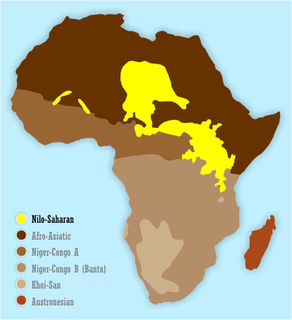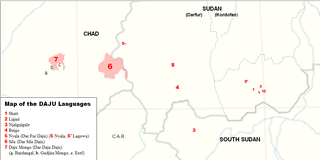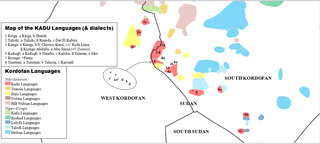
The Kordofanian languages are a geographic grouping of five language groups spoken in the Nuba Mountains of the Kurdufan, Sudan: Talodi–Heiban languages, Lafofa languages, Rashad languages, Katla languages and Kadu languages. The first four groups are branches of the Niger–Congo family, whereas Kadu is now widely seen as a branch of the Nilo-Saharan family.

The Niger–Congo languages are the world's third largest language family in terms of number of speakers and Africa's largest in terms of geographical area, number of speakers and number of distinct languages. It is generally considered to be the world's largest language family in terms of distinct languages, ahead of Austronesian, although this is complicated by the ambiguity about what constitutes a distinct language; the number of named Niger–Congo languages listed by Ethnologue is 1,540.

The Nilo-Saharan languages are a proposed family of African languages spoken by some 50–60 million people, mainly in the upper parts of the Chari and Nile rivers, including historic Nubia, north of where the two tributaries of the Nile meet. The languages extend through 17 nations in the northern half of Africa: from Algeria to Benin in the west; from Libya to the Democratic Republic of the Congo in the centre; and from Egypt to Tanzania in the east.

The Daju languages are spoken in isolated pockets by the Daju people across a wide area of Sudan and Chad. In Sudan, they are spoken in parts of the regions of Kordofan, Darfur, in Chad they are spoken in Wadai. The Daju languages belong to the Eastern Sudanic subfamily of Nilo-Saharan.

In most classifications, the Eastern Sudanic languages are a group of nine families of languages that may constitute a branch of the Nilo-Saharan language family. Eastern Sudanic languages are spoken from southern Egypt to northern Tanzania.

The Kadu languages, also known as Kadugli–Krongo or Tumtum, are a small language family of the Kordofanian geographic grouping, once included in Niger–Congo. However, since Thilo Schadeberg (1981), Kadu is widely seen as Nilo-Saharan. Evidence for a Niger-Congo affiliation is rejected, and a Nilo-Saharan relationship is controversial. A conservative classification would treat the Kadu languages as an independent family.

The Temein languages, or Nuba Hills languages, are a group of Eastern Sudanic languages spoken in the Nuba Mountains of Sudan.
The Heiban Nuba are a people of the Nuba Mountains in South Kordofan state, in southern Sudan.
The Talodi are a sub-ethnic group of the Nuba peoples in the Nuba Mountains of South Kordofan state, in southern Sudan. They likely number more than 1,000 people.
The Tima are an ethnic group of the Nuba Mountains in South Kordofan state, in southern Sudan. They number several thousands.

Sudan is a multilingual country dominated by Sudanese Arabic. In the 2005 constitution of the Republic of Sudan, the official languages of Sudan are Literary Arabic and English.
The Daju people are a group of seven distinct ethnicities speaking related languages living on both sides of the Chad-Sudan border and in the Nuba Mountains. Separated by distance and speaking different languages, at present, they generally have little cultural affinity to each other.
The Katla languages are two to three closely related languages that form a small language family in the Nuba Hills of Sudan. Part of an erstwhile Kordofanian proposal, they are of uncertain position within the Niger–Congo family. They do not share the characteristic morphology of Niger–Congo, such as the noun-class system. Thus Roger Blench classifies them as a divergent branch of Niger–Congo outside the Atlantic–Congo core. A similar situation holds for another Kordofanian family, Rashad; these are not closely related to Katla.

The Rashad languages form a small language family in the Nuba Hills of Sudan. They are named after Rashad District of South Kordofan.

The Talodi–Heiban languages are a branch of the Niger–Congo family spoken in the Nuba Mountains of Sudan. The Talodi and Heiban languages are thought to be distantly related by Dimmendaal, though Glottolog 4.0 does not accept the unity of Talodi–Heiban pending further evidence.
Moro is a Niger–Congo language in the Heiban family spoken by the Moro people in the Nuba Mountains of Kordofan, Sudan.
Dagik, also Dengebu, Dagig, Thakik, Buram, Reikha, is a Niger–Congo language in the Talodi family spoken in the Nuba Mountains in Kordofan, Sudan. It is 80% lexically similar with Ngile, which is also spoken by the Mesakin people.

Tegali is a Kordofanian language in the Rashad family, which belongs to the larger Niger–Congo phylum. It is spoken in South Kordofan state, Sudan.
Lafofa, also Tegem–Amira, is a Niger–Congo dialect cluster spoken in the southern Nuba Mountains in the south of Sudan. Blench (2010) considers the Tegem and Amira varieties to be distinct languages; as Lafofa is poorly attested, there may be others.
The Logorik are an ethnic group in the southern part of Sudan. They are one of seven distinct ethnicities comprising the Daju people. They speak the Logorik language, a Nilo-Saharan language. They live in the north, central Nuba Mountains in the Jebel Liguri hills area northeast of Kadugli. The population of this ethnic group likely exceeds 2,000.









